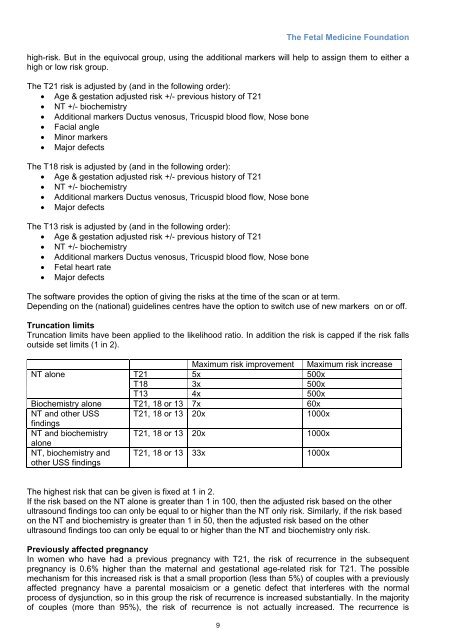Fetal Medicine Foundation First Trimester Screening
Fetal Medicine Foundation First Trimester Screening
Fetal Medicine Foundation First Trimester Screening
Create successful ePaper yourself
Turn your PDF publications into a flip-book with our unique Google optimized e-Paper software.
The <strong>Fetal</strong> <strong>Medicine</strong> <strong>Foundation</strong><br />
high-risk. But in the equivocal group, using the additional markers will help to assign them to either a<br />
high or low risk group.<br />
The T21 risk is adjusted by (and in the following order):<br />
• Age & gestation adjusted risk +/- previous history of T21<br />
• NT +/- biochemistry<br />
• Additional markers Ductus venosus, Tricuspid blood flow, Nose bone<br />
• Facial angle<br />
• Minor markers<br />
• Major defects<br />
The T18 risk is adjusted by (and in the following order):<br />
• Age & gestation adjusted risk +/- previous history of T21<br />
• NT +/- biochemistry<br />
• Additional markers Ductus venosus, Tricuspid blood flow, Nose bone<br />
• Major defects<br />
The T13 risk is adjusted by (and in the following order):<br />
• Age & gestation adjusted risk +/- previous history of T21<br />
• NT +/- biochemistry<br />
• Additional markers Ductus venosus, Tricuspid blood flow, Nose bone<br />
• <strong>Fetal</strong> heart rate<br />
• Major defects<br />
The software provides the option of giving the risks at the time of the scan or at term.<br />
Depending on the (national) guidelines centres have the option to switch use of new markers on or off.<br />
Truncation limits<br />
Truncation limits have been applied to the likelihood ratio. In addition the risk is capped if the risk falls<br />
outside set limits (1 in 2).<br />
Maximum risk improvement Maximum risk increase<br />
NT alone<br />
T21 5x 500x<br />
T18 3x 500x<br />
T13 4x 500x<br />
Biochemistry alone T21, 18 or 13 7x 60x<br />
NT and other USS T21, 18 or 13 20x 1000x<br />
findings<br />
NT and biochemistry T21, 18 or 13 20x 1000x<br />
alone<br />
NT, biochemistry and<br />
other USS findings<br />
T21, 18 or 13 33x 1000x<br />
The highest risk that can be given is fixed at 1 in 2.<br />
If the risk based on the NT alone is greater than 1 in 100, then the adjusted risk based on the other<br />
ultrasound findings too can only be equal to or higher than the NT only risk. Similarly, if the risk based<br />
on the NT and biochemistry is greater than 1 in 50, then the adjusted risk based on the other<br />
ultrasound findings too can only be equal to or higher than the NT and biochemistry only risk.<br />
Previously affected pregnancy<br />
In women who have had a previous pregnancy with T21, the risk of recurrence in the subsequent<br />
pregnancy is 0.6% higher than the maternal and gestational age-related risk for T21. The possible<br />
mechanism for this increased risk is that a small proportion (less than 5%) of couples with a previously<br />
affected pregnancy have a parental mosaicism or a genetic defect that interferes with the normal<br />
process of dysjunction, so in this group the risk of recurrence is increased substantially. In the majority<br />
of couples (more than 95%), the risk of recurrence is not actually increased. The recurrence is<br />
9
















